WHO and UN team to create postpartum hemorrhage detection and treatment bundle
As awareness spreads on the adverse impact caused by postpartum hemorrhage, investigators are working to streamline management.
WHO and UN team to create postpartum hemorrhage detection and treatment bundle | Image Credit: © hectorchristiaen - © hectorchristiaen - stock.adobe.com.

Postpartum hemorrhage continues to be a serious and significant complication of childbirth, even in the United States. However, international investigators are working to develop a protocol that could help streamline the process for recognizing and treating severe maternal bleeding.
Postpartum hemorrhage, which is a severe form of bleeding after childbirth, contributes to more than 70,000 maternal deaths globally every year, according to the World Health Organization (WHO). Approximately 14 million women worldwide experience this complication annually, and even when treatment is successful, the surgical steps to control the bleeding often cause permanent reproductive issues.1
Although postpartum hemorrhage is a more significant problem in countries with limited health care resources or utilization, it remains a serious problem in developed countries such as the United States. A study published in the January 2023 edition of Obstetrics & Gynecology revealed that postpartum hemorrhage rates in the United States increased from 2.7% in 2000 to 4.3% in 2019.2 The proportion of deliveries where at least 1 postpartum hemorrhage risk factor was present increased from 18.6% to nearly 27% during the study period, according to the report. Overall, nearly 77 million deliveries were reviewed, and the postpartum hemorrhage rate was approximately 3% during the 2-decade study period.2 Some of the main risk factors in the United States included2:
- Prior cesarean delivery with placenta previa or placenta accrete
- Placenta previa without prior cesarean delivery
- Antepartum hemorrhage
- Placental abruption
Surgical intervention is a leading treatment for postpartum hemorrhage, along with supportive measures such as blood transfusions. Blood transfusions after postpartum hemorrhage increased from 5.4% to 16.7% from 2000 to 2011, then decreased to 12.6% by 2019, according to the report in Obstetrics & Gynecology. Hysterectomies increased from 1.4% in 2000 to 2.4% in 2009, with little change from 2009 to 2016, followed by a drop to below the initial baseline (2.1% in 2000 to 0.9% in 2019) by the end of the study.2
Although improvements in the prevention and clinical management of postpartum hemorrhage may have yielded some improvement in recent years in the United States, more work needs to be done to realize similar outcomes globally. A new report published in the New England Journal of Medicine explores the use of bundled interventions to improve postpartum hemorrhage rates, especially in secondary-level hospitals around the world.3
The study group defined postpartum hemorrhage as a blood loss of at least 500 mL after delivery and credited this problem for approximately 27% of maternal deaths during childbirth to this problem. The availability and use of resources vary around the world, but the study group, which was led by investigators from the United Nations (UN) and the WHO, identified 3 key issues in reducing postpartum hemorrhage rates:
Late detection and underestimated blood loss. Late detection of postpartum hemorrhage leads to delayed intervention, according to the report. Only approximately 53% of postpartum hemorrhage cases detailed in the study were identified early enough to be treated with uterotonic medications that could prevent more invasive interventions. Currently, visual estimates are the most used tool for assessing maternal blood loss during childbirth, although this technique is widely recognized as inaccurate.
Delayed intervention and inconsistent practices. Postpartum hemorrhage is often treated with a sequential series of interventions, with each step often being delayed until the effect of the prior step is assessed. The study team faults this approach, noting that the management of postpartum hemorrhage is time critical, and delays in care or the absence of certain treatments altogether have a large impact on fatality rates. For example, the research team found that the antifibrinolytic agent tranexamic acid was either skipped completely or used as a last resort in hospitals in many developing areas.
Poor adherence to guidance. Clear and consistent recommendations on how to manage postpartum hemorrhage exist but are poorly implemented at the point of care in many parts of the world, the study suggests. Staffing, education, and a lack of buy-in from providers are all contributing factors, according to the report.
To address these 3 areas of concern, the UN/WHO team developed a multifaceted approach to detecting and managing postpartum hemorrhage, called the E-MOTIVE intervention. Some interventions trialed in this intervention included things like the use of a calibrated drape to collect and measure maternal blood loss for early hemorrhage detection, as well as first-response treatments that include:
- Uterine massage
- Oxytocic medications
- Tranexamic acid
- Intravenous fluid administration
- A clear plan and process for examination and escalation of care
Trolleys or cases with supplies were provided to participating study sites, along with simulation-based or on-site training. Local midwives, doctors, and other maternal providers were identified as local champions and provided ongoing support, and they provided feedback to the study team after training.
In the hospitals where the bundle was implemented, postpartum hemorrhage was detected in 93.1% of deliveries compared with 51.1% in the control centers where traditional assessment and treatment methods were used. Adherence to the techniques in the treatment bundle was 91.2% at the study group hospitals compared with 19.4% at the control group hospitals.
Median blood loss was approximately 160 mL in the study group compared with approximately 220 mL in the control groups, and postpartum hemorrhage was officially diagnosed in 8.5% of patients in the intervention group compared with 16.7% in the control group that followed usual care practices. Severe postpartum hemorrhage, which was defined as blood loss of 1 L or more, occurred in 1.6% of deliveries in the intervention group and 4.3% in the control group. Blood transfusions were fairly consistent across both groups, at 1.2% and 1.9%, respectively, and there were 17 maternal deaths in the intervention group compared with 28 deaths in the usual care group. Twelve of the 17 deaths in the intervention group and 18 of the 28 deaths in the usual care group were attributed specifically to postpartum bleeding, according to the report.
There were some limitations to comparison between the 2 groups, as surgical intervention was limited in both the intervention and control groups. However, the report notes that the E-MOTIVE process helped to trigger the use of the treatment bundle whenever there was blood loss of 300 mL or more, along with other changes in vital signs or clinical observations.
The report also investigated the efficacy of the use of a calibrated drape to estimate blood loss instead of visual inspection. One trial found that the drape was effective in more accurately estimating blood loss but had no clear effect on overall outcomes, whereas another larger trial attributed the use of the drape alongside other bundled interventions with better outcomes compared with usual care methods.
Overall, the study team concluded that the tools, training, and assessment methods advocated in the E-MOTIVE treatment bundle could help to lower the risk of fatal postpartum hemorrhage when used effectively. Adam Devall, PhD, one of the study authors and a member of the WHO Collaborating Centre for Women’s Health, says the WHO is currently considering implementation of the E-MOTIVE bundle at a global level to better understand its efficacy and benefit potential.
References
- Sexual and Reproductive Health and Research (SRH): Postpartum hemorrhage. World Health Organization. Accessed May 29, 2023.
https://www.who.int/teams/sexual-and-reproductive-health-and-research-(srh)/areas-of-work/maternal-and-perinatal-health/postpartum-haemorrhage - Corbetta-Rastelli CM, Friedman AM, Sobhani NC, Arditi B, Goffman D, Wen T. Postpartum hemorrhage trends and outcomes in the United States, 2000-2019. Obstet Gynecol. 2023;141(1):152-161. doi:10.1097/AOG.0000000000004972
- Gallos I, Devall A, Martin J, et al. Randomized trial of early detection and treatment of postpartum hemorrhage. N Engl J Med. Published May 9, 2023. doi:10.1056/NEJMoa2303966

S4E1: New RNA platform can predict pregnancy complications
February 11th 2022In this episode of Pap Talk, Contemporary OB/GYN® sat down with Maneesh Jain, CEO of Mirvie, and Michal Elovitz, MD, chief medical advisor at Mirvie, a new RNA platform that is able to predict pregnancy complications by revealing the biology of each pregnancy. They discussed recently published data regarding the platform's ability to predict preeclampsia and preterm birth.
Listen
